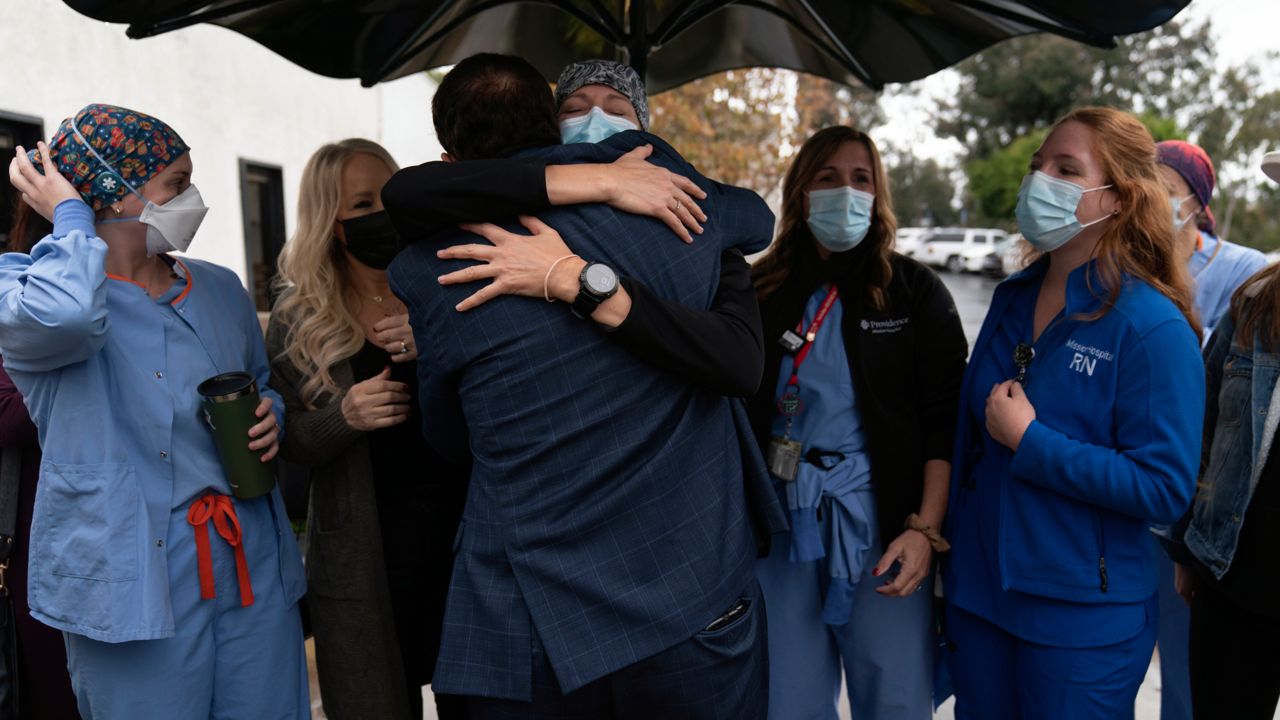MISSION VIEJO, Calif. (AP) — Brian Patnoe never saw the faces of the masked health care workers who nursed him back to health from the coronavirus that nearly killed him. But he knew each by their eyes, which peered out through layers of protective gear as he lay in their hospital’s COVID-19 unit.
He was reunited Thursday with some of those who treated him for weeks after he arrived at Providence Mission Hospital in March 2020, just as the virus was descending on California. They still wore masks and he still recognized them.
“It’s amazing how I saw all the eyes and I was like, ‘I know you, I know you, I know you,’” the 62-year-old Patnoe said, his own eyes welling with tears while embracing each of a half-dozen nurses who lined up to greet him outside the hospital in Southern California’s Mission Viejo. “Oh, my God, thank you guys for keeping me alive.”
Patnoe and other coronavirus survivors held an emotional reunion with the nurses, respiratory therapists and doctors who saved their lives at a time when little was known about the virus. They shared hugs, memories and photos at an event marking the hospital’s 50th anniversary and added items to a time capsule created so future generations will remember the pandemic. It’s to be opened in 2071.
It also was a reunion for the staff that volunteered to work in the hospital’s first coronavirus unit. Many have moved on to other jobs.
The unit members dubbed themselves the “Tip of the Spear” for taking on the virus in the early days of the pandemic when they didn’t know if they had adequate protective gear or exactly what would save their patients. Many later tattooed spears onto their wrists, with a heart.
“We all felt like we had all bonded. We had all volunteered,” nurse Christina Anderson said.
When the pandemic arrived, protective gear was in frightfully short supply, and so was toilet paper. Dr. Robert Goldberg, a pulmonary and critical care specialist, recalled how doctors had to wait weeks to get COVID-19 test results confirmed for their patients.
“We really didn't know what we were facing,” he said.
California was the first state in the nation to issue a shutdown order in 2020 and faired relatively well in the early months. But by the end of the year, the state was the U.S. epicenter for the virus and many hospitals were overwhelmed.
While the outlook has improved vastly with vaccinations, the virus remains a threat. Deaths in the state are lower on a per-capita basis than most others but hundreds still die weekly and the average daily number of cases has climbed nearly 70% in the past two weeks, according to data compiled by Johns Hopkins University.
The time capsule created at the hospital about 45 miles (72 kilometers) southeast of Los Angeles aims to create a memory for future generations of what happened there during the pandemic. Items collected include a cloth face mask, a fire department patch, a copy of a sign telling people to “mask up to open up” and “we can do this,” and letters and photos from patients.
Patricia Gomez, 32, submitted photos taken of her and the nurse who delivered her baby in July 2020, when she was ravaged by COVID-19. Her newborn son was able to leave the hospital quickly and tested negative for the virus, but she had to stay another week because she was so ill.
“I was scared that I wasn't going to make it,” she said. “But I was so grateful. The nurses were always caring. I never felt alone.”
Patnoe, who was out of work for six months, recalled vivid dreams during his two stints on a ventilator. In one, his late mother, who was a nurse, came over to him and said he wasn’t ready to “come here” yet.
In the time capsule, he included a copy of a photo snapped when he was finally released from the hospital. That day, he said, nurses and doctors lined up and clapped as he was wheeled down the hall and outside to finally see his family. It was a far cry from how the halls emptied out when he was brought in as one of the hospital's first COVID-19 patients.
“I'm so lucky to be alive,” he said. “I think we've become a little desensitized to it just right now, because it's become such a common thing.”
Since Patnoe left, the hospital has seen hundreds of coronavirus patients. In the COVID-19 intensive care unit, staff kept a tally of survivors and logged the initials of those who didn’t make it, Goldberg said.
After last year’s winter spike, hospitalizations plummeted and the hospital shut down the unit, he said.
It’s now back up and running, Goldberg said, with the community heading into winter and coronavirus cases rising again.



